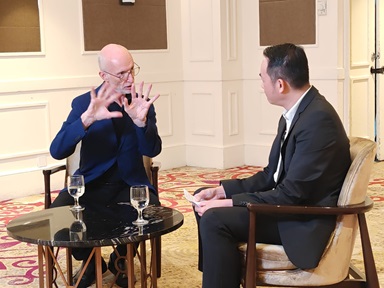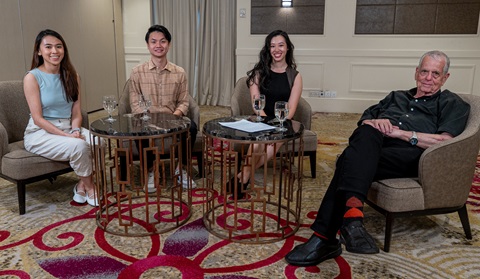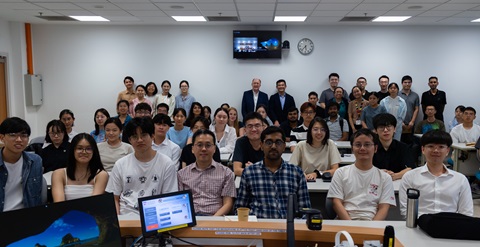Tea Session with Millennium Technology Prize Laureates Prof Martin Green and Prof Sir Shankar Balasubramanian
Tey Yee Han (CN Yang Scholar, School of Biological Sciences) and Shivam Mahajan (Research Fellow, School of Physical and Mathematical Sciences), NTU
On 10 Jan 2024, the Institute of Advanced Studies (IAS) at Nanyang Technological University hosted the Lee Kong Chian Distinguished Professor Public Lecture featuring two distinguished speakers: Prof Martin Green (Millennium Technology Prize laureate 2022) and Prof Sir Shankar Balasubramanian (Millennium Technology Prize laureate 2020). Prof Martin Green delivered a presentation on cutting-edge technologies in solar power, leading to the achievement of "insanely cheap" solar energy. Sir Shankar Balasubramanian, on the other hand, emphasised the role of Next Generation DNA Sequencing (NGS) in enabling cost-effective and large-scale genome sequencing. Despite the diverse topics of solar cells and human genomes, the shared objective of cost reduction and the societal impacts of both technologies connected them.
The public lecture concluded with a dialogue and tea session for NTU scholars and young scientists, providing them an opportunity to interact and discuss various questions with the two eminent speakers.
 Prof Martin Green (seated third from the left) and Prof Sir Shankar (to Prof Martin's right) during the tea session with NTU scholars and young scientists.
Prof Martin Green (seated third from the left) and Prof Sir Shankar (to Prof Martin's right) during the tea session with NTU scholars and young scientists.
Have you ever wondered why understanding DNA is crucial and what set humans apart from other organisms? Sir Shankar simplified complex concepts about DNA's structure for the layman, using the analogy of a bowl of spaghetti. Despite resistance to change among some evolutionary biologists, he emphasised the importance of exploring the fundamental structure of DNA. While DNA contains protein-coding genes, a significant portion known as non-coding DNA was historically dismissed as "junk". Contrary to this perception, these non-coding segments play a crucial role in intricately controlling protein-coding genes.
Using the nematode worm as an example, Sir Shankar noted that both humans and nematodes shared a similar count of protein-coding genes, but what distinguished us were the non-coding genes. Referring back to the DNA-as-spaghetti analogy, he explained that the folding of DNA allows certain Adenosine (A), Thymine (T), Cytosine (C), and Guanine (G) components to be in close proximity, influencing mutation patterns. In this context, he highlighted that the most common nucleotide substitution is C converted to T, leading to genetic changes and heterogeneity.
 Sir Shankar’s DNA-as-spaghetti analogy intrigued the participants.
Sir Shankar’s DNA-as-spaghetti analogy intrigued the participants.
Separately, a Ph.D. student asked Prof Martin Green about the prospective developments in solar cells and whether alternative energy sources would completely transform the field. In the context of solar cell technologies, the removal of barriers expedites the installation of solar panels. Prof Green raised the possibility that augmented funding from the United States, a solar technology leader, could amplify the ease and speed of installation. Sir Shankar mentioned the aspect of 'NIMBYism' (Not In My Backyard) in the UK, suggesting that such attitudes might hinder the widespread adoption of these innovative technologies.
Given the widespread utilisation of solar power, one may question the disparities between research in academia and industry practices. As technologies originating in academia advance, concerns arise regarding their smooth integration into industry settings. Prof Green noted a trend where results from commercial labs often outperform those from academic labs, prompting discussions about the necessity of complexity. Despite the undervaluation of the engineering process in industrialising academic work, questions surface about whether research should prioritise innovative methods and materials like Perovskites. The discourse extended to whether these emerging technologies would surpass current ones or if the focus should be on integrating them into the well-established silicon industry. Prof Martin Green contemplated the feasibility of adopting pioneering technologies, emphasising the potential long-term consequences of even minor alterations. The resistance to change within established silicon manufacturing poses challenges, as industry professionals tend to explore new technologies gradually.
Nevertheless, it's essential to note that deeming it impossible would be premature. Prof Green highlighted the emergence of start-up companies poised to adopt new methods, potentially expediting the surpassing of the silicon industry. Yet, determining an exact timeframe for the potential overtaking of the silicon industry remains challenging, given the empirical nature of start-up success, with some ventures encountering failure.
Expanding on this point, there is a crucial consideration regarding how the academic community can adapt its mindset to facilitate a smooth transition from pure academic research to research with practical applications. In essence, the question arises: How can academic research be effectively commercialised? Prof Green delved into a specific avenue for achieving this integration - licensing. He noted that among engineers, it is a prevalent practice to submit a patent application whenever they encounter a groundbreaking idea or innovation. However, the decision on whether to uphold the filed patent, and thereby enable commercialisation, lies with the university. This entails a thorough evaluation to determine if the patent holds sufficient value and is feasible for another significant span of eight to ten years. In essence, licensing becomes a strategic mechanism to bridge the gap between academic innovation and real-world applications by providing a structured pathway for the commercialisation of valuable intellectual property.
 Participants attentively listening to insights from Prof Green and Sir Shankar, moderated by Prof Fan Hongjin, Director of CN Yang Scholar Programme at NTU (seated facing the camera).
Participants attentively listening to insights from Prof Green and Sir Shankar, moderated by Prof Fan Hongjin, Director of CN Yang Scholar Programme at NTU (seated facing the camera).
During the session, an inquiry surfaced about the stereotypical unhealthy lifestyle often associated with Ph.D. students, sparking amusement within the function room. The question revolved around the potential impact of such lifestyles on DNA. In response, Sir Shankar provided an elaborate explanation of the consequences that unhealthy habits may have on genetic makeup. He delved into the known shifts in the epigenome, emphasising that evidence suggests stress can detrimentally affect the immune system and disrupt homeostasis processes within the body. Factors such as alcohol consumption, stress, and exposure to undesirable environmental conditions were highlighted as elements influencing DNA repair mechanisms. These influences, in turn, contribute to genetic changes and the introduction of heterogeneity within one's DNA. Injecting a touch of humour by acknowledging the controversial realm of aging biology, often backed by billionaires seeking longevity, Sir Shankar underscored the idea that organ dysfunction may potentially initiate from gene disrepair. The evidence presented suggested a link between unhealthy lifestyles and genetic alterations in one's DNA, emphasising the importance of considering lifestyle factors in the broader context of genetic health.
As cost reduction curves continue to decline, a young scientist asked Prof Martin Green about the fate of older solar modules and discussions concerning the recycling of aged solar panels, acknowledging the potential recycling of aluminum frames and partial recycling of glass. Addressing the modules at the conclusion of their lifespan poses challenges. Despite claims of the modules having a 50-year durability, material disintegration may occur much earlier, resulting in elevated maintenance costs.
In discussing the cost reduction curves for new solar panels, Prof Green highlighted that the values are derived from market survey companies that assess the average cost of a solar panel module across the industry. It's important to note that this average may differ from the actual cost that a bidder in an auction company might be willing to pay. Thus, while the cost reduction curve serves as a reference point, it may not accurately represent the genuine cost of solar panel modules in practical scenarios.
 Inquisitive participants engaging in an interactive discussion with Prof Martin Green on the cost reduction of new solar panels.
Inquisitive participants engaging in an interactive discussion with Prof Martin Green on the cost reduction of new solar panels.
In response to a question about the trajectory that Ph.D. students should consider in their final year, Prof Martin Green and Sir Shankar provided insightful responses based on their personal journeys. Prof Green recounted his experience under an Australian scholarship to study in Canada, expressing a preference for returning to Australia despite abundant opportunities in the United States. He recommended pursuing endeavous relevant to the industry, expressing a personal inclination towards academia or engaging in research within a company. Sir Shankar suggested considering exposure to a different country and system after completing a Ph.D. for valuable experience. Drawing from his own experience, he emphasised that research practices vary across countries, stating, "Research isn't done the same in every country." He highlighted the importance of exploring different perspectives and opportunities, especially during the formative stage of one's career. Ultimately, he advised focusing on projects that personally stimulate and resonate with the individual.
Sir Shankar also illustrated examples of start-up companies featuring Ph.D. students turned entrepreneurs and CEOs, which garnered significant admiration during the tea session. In response to inquiries about the steps necessary to transition successfully from academia to industry and assume a CEO role, Sir Shankar shared valuable insights. He pointed to the notable example of Apple, the world's largest company founded by Steve Jobs, who lacked an undergraduate degree or traditional accreditations. Sir Shankar emphasised that there is no fixed set of experiences or specific credentials required to become a CEO. Drawing attention to his own experiences, he highlighted two Ph.D. students who, despite lacking real-world experience, became a CEO and a CTO. The CEO exhibited natural entrepreneurial qualities and sought guidance from seasoned CEOs, even recruiting them to advisory roles. Sir Shankar stressed the importance of the CEO's ability to learn on the job, deeming it an indispensable quality for success in such a leadership role.
A Ph.D. student inquired about the motivation behind Sir Shankar's decision to establish a company and delve into the field of DNA sequencing, considering the intricacies and time-consuming nature of the process. Initially envisioning a three to four-year project, Sir Shankar admitted to underestimating the actual time required. Interestingly, the project didn't commence with a primary focus on DNA sequencing; rather, the team identified an opportunity to pivot towards DNA sequencing due to its widespread availability. Sir Shankar highlighted the dynamic nature of their environment, emphasising the importance of connecting with influential figures in the field such as Sydney Brenner, Crick-Watson, and the Human Genome Project. He underscored the notion that the individuals one interacts with shape the opportunities that come into view. Ultimately, armed with ample information and diligence, Sir Shankar stressed that what truly mattered was his enthusiasm and commitment to endure the challenges inherent in the DNA sequencing endeavour.
 Delightful group photo after a profound intellectual exchange with the eminent speakers.
Delightful group photo after a profound intellectual exchange with the eminent speakers.
In summary, the insightful dialogue and tea session with the two experts delved into progress in solar technologies and Next Generation DNA Sequencing (NGS), covering topics such as DNA structure, the genetic impact of lifestyle, solar module recycling, and challenges in industry integration, underlining the significance of innovation and the uncertain path of start-ups.







